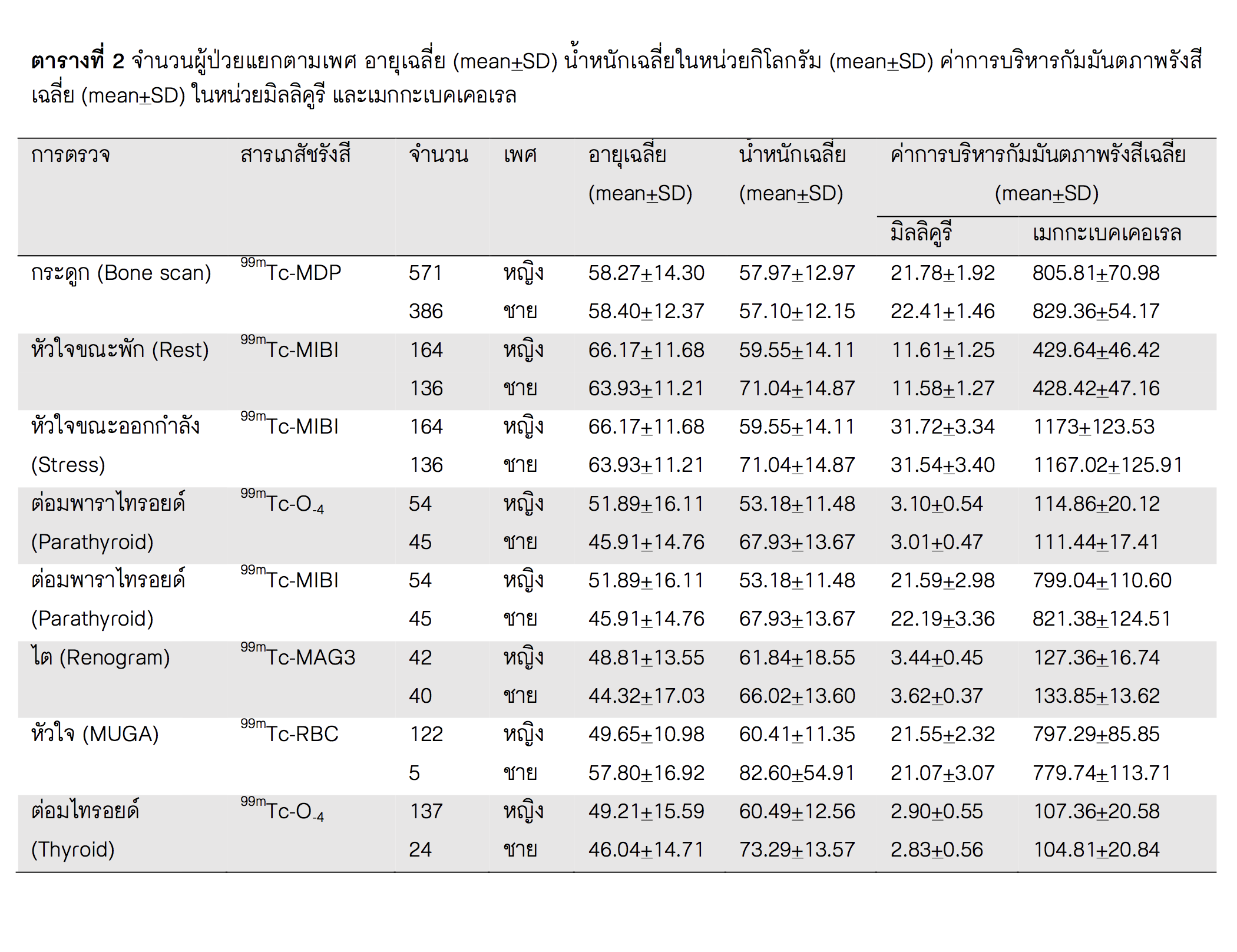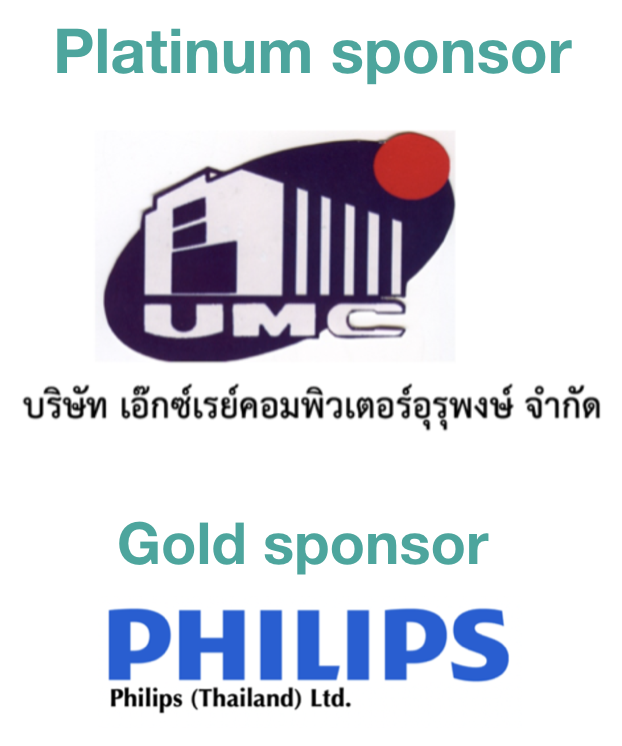The survey of local diagnostic reference levels (DRLs) for administered activity in diagnostic nuclear medicine at Rajavithi Hospital
Keywords:
Diagnostic reference levels (DRLs), administered activity, diagnostic nuclear medicineAbstract
Background: Diagnostic reference levels (DRLs) is the useful tools for the radiation exposure reduction. DRLs in diagnostic nuclear medicine is referred to the administered activity to the patients. In Thailand, the national DRLs is not yet established at this moment. Therefore, this study aimed to determine the DRLs for diagnostic nuclear medicine procedure at Rajavithi Hospital. Objective: To survey and initiate the local DRLs for administered activity in Nuclear Medicine Division at Rajavithi Hospital and compare the DRLs with other countries. Methods: This was the retrospective survey data from the patients who underwent Nuclear Medicine examination in 2019 at Rajavithi Hospital. The mean, median and 75thpercentile of the administered activities were reported. As International organization reported the value of DRL using 75th percentile value, this survey compared the 75th percentile value from Rajavithi Hospital with other countries and International organization. Then the percentage difference was calculated to determine the DRLs difference between Rajavithi Hospital and others. Results: For bone scan (571 females, 386 males, mean age 58.32+13.55), the DRL for 99mTc-MDP was 858.03 MBq (23.19 mCi). The one day protocol of myocardial perfusion scan (164 females, 136 males, mean age 65.16+11.51), the DRL for 99mTc-MIBI (rest) was 473.23 MBq (12.79 mCi) and the DRL for 99mTc-MIBI (stress) was 1281.03 MBq (34.62 mCi). For parathyroid subtraction scan (54 females, 45 males, mean age 49.17+15.72), the DRL for 99mTc-pertechnetate was 123.39 MBq (3.33 mCi) and for 99mTc-MIBI was 902.98 MBq (24.40 mCi). The DRL for 99mTc-MAG3 in renogram scan (42 females, 40 males, mean age 46.62+15.41) was 139.12 MBq (3.76 mCi). For MUGA scan (122 females, 5 males, mean age 49.97+11.28), the DRL for 99mTc-RBC was 854.70 MBq (23.10 mCi). Lastly, for thyroid scan (137 females, 24 males, mean age 48.74+15.46), the DRL for 99mTc-pertechnetate was 116.18 MBq (3.14 mCi). Conclusions: The percentage difference between Rajavithi local DRL and other countries was between 16-83%. The ones which were higher than other countries were 99mTc-MIBI (stress), 99mTc-MIBI (parathyroid) and 99mTc-RBC (MUGA scan). Therefore, these three radiopharmaceuticals for these certain types of studies should be taken into account. However, these local DRLs of administered activities should be compared and adjusted in the future when the National DRLs of administered activities are published.
Downloads
References
Applegate KE, Cost NG. Image Gentry: A campaign to reduce children’s and adolescents’ risk for cancer during adulthood. J. Adolese Health. 2013; 52: 593-597
Rehani MM, Vassileva J. Diagnostic Reference Levels. AJR 2015;204:w1-w3 Available from https://www.ajronline.org/doi/pdf/10.2214/AJR.14.12794
Song HC, Na MW, Kim J, Cho SG, Park JK, Kang KW. Diagnostic reference levels for adult nuclear medicine imaging established from national survey in Korea. Nucl Med Mol Imaging. 2019 Feb; 53(1): 64–70 Available from https://www.ncbi.nlm.nih.gov/pmc/articles/PMC6377576/
Abe K, Hosono M, Igarashi T, et al. The 2020 national diagnostic reference levels for nuclear medicine in Japan. Ann Nucl Med 2020;34:799-806 Available from https://www.ncbi.nlm.nih.gov/pmc/articles/PMC7584529/pdf/12149_2020_Article_1512.pdf
European Commission. Diagnostic reference levels in thirty-six European countries. Part2/2 2014 Available from https://ec.europa.eu/energy/sites/ener/files/documents/RP180%20part2.pdf
Australian Radiation Protection and Nuclear Safety Agency. Available from https://www.arpansa.gov.au/sites/default/files/nuclear-medicine-diagnostic-reference-levels.pdf
Ali WM, Elaward RM, Ibrahim MAA. Establishment of dose reference levels for nuclear medicine in Sudan. Available from https://www.scirp.org/pdf/ojrad_2016101815345438.pdf
ACR-AAPM Practice parameter for reference levels and achievable administered activity for nuclear medicine and molecular imaging. Available from https://www.acr.org/-/media/ACR/Files/Practice-Parameters/RefLevels-NucMed.pdf

Downloads
Published
How to Cite
Issue
Section
License
บทความที่ได้รับการตีพิมพ์เป็นลิขสิทธิ์ของสมาคมรังสีเทคนิคแห่งประเทศไทย (The Thai Society of Radiological Technologists)
ข้อความที่ปรากฏในบทความแต่ละเรื่องในวารสารวิชาการเล่มนี้เป็นความคิดเห็นส่วนตัวของผู้เขียนแต่ละท่านไม่เกี่ยวข้องกับสมาคมรังสีเทคนิคแห่งประเทศไทยและบุคคลากรท่านอื่น ๆในสมาคม ฯ แต่อย่างใด ความรับผิดชอบองค์ประกอบทั้งหมดของบทความแต่ละเรื่องเป็นของผู้เขียนแต่ละท่าน หากมีความผิดพลาดใดๆ ผู้เขียนแต่ละท่านจะรับผิดชอบบทความของตนเองแต่ผู้เดียว




